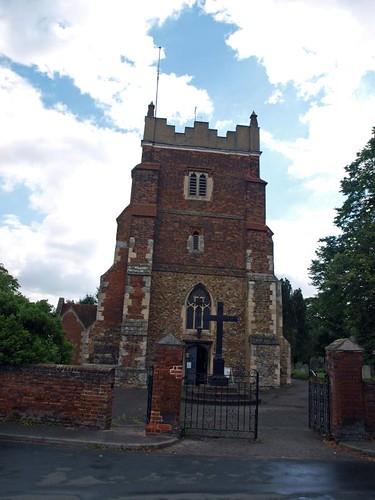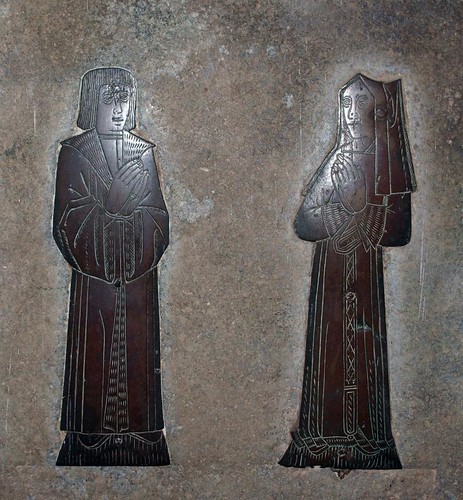Most, if not all, the churches in this area were affected to some degree or another by the 1884 earthquake which resulted in reparations and rebuilds which, to my eye, were done mostly sympathetically but with a distinct Victorian bent. I'm getting soft as I progress through my churches but think that due to the massive undertaking of the various restorations I can forgive our forebears any overzealousness in these particular churches.
St Mary the Virgin has an impressive tower, a couple of brasses and an interesting modern north wall window.
A little town rather than a village, with a real square by the church. At the NW corner of the churchyard, in the square, the LOCKUP, a small weatherboarded shed with an iron grille in the door.
ST MARY. Nave and W tower C11, see the nave N and S windows and the rear-arch of the S doorway. The tower was heightened in brick about 1600. It has stepped battlements. The chancel was rebuilt in 1872. - FONT. Octagonal, C18, with an inscription: ‘Good people all I pray take care, That in ye church you do not sware. As this man did’. - STAINED GLASS. E window by Kempe 1902. - PLATE. Cup of 1562 with three bands of ornament. - MONUMENTS. Brasses to Thomas Freshwater d. 1517 and wife, figures of 17 in. length. - Jane Gardiner d. 1654. Handsome tablet with oval inscription plate surrounded by fanciful scrolls and crowned by an open scrolly pediment.
TOLLESBURY. Lying near the Blackwater estuary, a centre of the oyster hsheries, its streets have many quaint old buildings. The green has become a paved square, and round it stand tiled cottages of many ages and the long, low brick walls of the churchyard. A battered wooden building with an acorn-shaped iinish was the lock-
up for the village ne’er-do-wells. Sloping down to the south wall of the churchyard is the tiled roof of three houses into which the 15th century hall has been divided.
The square is dominated by the massive tower which rests on the oldest stones the village has, a rubble foundation of Saxon times. Indoors above the 14th century tower arch, is a course of Roman tiles the Saxon builders used, and over the 15th century doorway is a lofty arch of similar tiles. A Norman window close by has a representation in modern glass of St Cedd, the Saxon bishop who built the first churches in Essex. In the modern chancel is a richly carved monument to Jane Gardiner, who died in 1654. On a wall-brass in the nave are 400-year-old portraits of Thomas Freshwater in a furlined gown, with his wife and their nine children.
The small font may pass unnoticed, yet it has an odd little story. It was obtained for the church in 1718 by a strong-willed church-warden, Robert Joyce, from a certain John Norman, who came into church cursing and talking loudly during service. To prevent his being prosecuted he paid five pounds, and out of this sum the font wasbought, the churchwardcn having these wise words put boldly round the bowl:
Good people all, I pray take care
That in the church you do not swear
As this man did.
Simon K -
We left Tolleshunt D'arcy past White Farm, site of the notorious
murders of August 1985. We were on the way to one of Essex's more
obscure outposts. Tollesbury is really out on the end of it all,
looking out to sea at the mouth of the Blackwater with just one road
into it, and the nearest town of any size is Maldon. There is a pretty
market place and beside it a curious church built of every material
you can mention - Roman brick, Tudor brick, Victorian brick, ragstone,
puddingstone, flint and even concrete. The overall effect is not
entirely attractive.
Open. A big sign said Our historic church is open every day, and I had to smile, because it was as if the locked churches and
open churches around here were competing. The interior was warm and
inviting, some super modern glass and an excellent Kempe east window,
and I'm not usually a fan. below it is a very Anglo-Catholic reredos
by Christopher Webb. If I tell you that the congregation here is
clearly evangelical in character, they are really to be congratulated
in keeping the sacramental integrity of the building intact and being
so welcoming. The visitors book shows they get a huge number of
visitors in the summer, hardly any in the winter! The most unusual
feature of the church is an early 18th Century font bearing the
inscription Good people all I pray take care, That in ye Church you doe not sware,
As this man Did. The suggestion is that the font was donated as an act of penance and
reparation by someone for swearing in church. Fascinating.
And so, we turned towards Colchester, with the prospect of a number of
small churches in quick succession, not least because we were now
entering earthquake country.



No comments:
Post a Comment